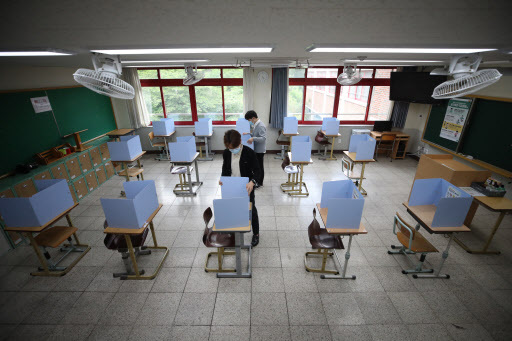Despite lingering concerns over coronavirus, South Korea will take another step toward normalizing life Wednesday, sending some 2.37 million pupils across the country back to classrooms.
In the second phase of the country’s staged school reopening, which began a week ago with high school seniors, in-person classes will resume for students in kindergarten, second year of high school, third year of middle school and first two years of elementary school.
About 200 schools in high-risk areas, including 11 in Seoul, will remain closed.
School normalization would decide the success or failure of the country’s “everyday life quarantine” regime, currently in place as a way to exit from the coronavirus epidemic, President Moon Jae-in said during a Cabinet meeting.
“The government is fully awareness of the worries of parents and we’re all on the same page when it comes to protection of children. The government will make every effort to ensure safety at school,” he said.
Safety concerns persist over school reopening as South Korea continues to see sporadic, small-scale virus outbreaks involving teachers and students.
In Seoul, an elementary student tested positive Tuesday morning, which forced the student’s school to delay the planned opening at the last-minute. Several schools in northwestern Seoul have also delayed class resumption after a 6-year-old kindergarten student who tested positive Monday is believed to have contracted the virus from his art teacher at a private art school in Magok of Gangseo-gu. The art teacher, who tested positive Sunday, taught 35 students and had contact with three co-teachers at the institute until Friday.
In Bucheon, Gyeonggi Province, a 58-year-old elementary school teacher tested positive, leading to a delay in the affected school’s plan.
In North Gyeongsang Province’s Gumi and Sangju, where a private cram school teacher and a priest were found to have COVID-19, at least 185 schools will remain closed.
High school seniors are back in classrooms since last Wednesday, as they face a hectic academic schedule in preparation for the annual college entrance exam slated for early Dec. 3.
With nearly 98 percent of the students attending 2,358 high schools daily, no incident of virus transmission at schools has been reported so far, the Education Ministry said.
A total of 8,187 high school seniors were tested for the coronavirus, with one student in Daegu having tested positive last week. Some 4,173 students are awaiting their testing results. As for teachers, 271 people were tested, 174 of whom are awaiting their results, according to the data by the ministry.
Parents still are still worried because it is younger students, who are more likely to find it difficult to comply with personal hygiene and social distancing rules, are going back to school this time.
“I am worried about sending my children back to school since infections linked to the Itaewon clubs surfaced,” said Lee Sung-eun, mother of two children aged 8 and 11. “I feel it’s still too early to send them back to school, but I also understand we cannot delay it indefinitely.”
Her children will go to school twice a week, with the size of their classes to be divided in two.
“My biggest concern is that they are young and I don’t think they will strictly follow personal hygiene rules such as wearing a mask, especially as the weather gets hotter,” she said.
While education authorities provide basic guidelines in running schools during the pandemic, schools are given discretion to decide how they would run classes once students are back -- from how many times pupils would come to school a week and how their academic performance would be evaluated.
Many schools conducted a survey on parents and teachers to decide how they will run classes.
“Through a survey, it was decided children will attend in-person classes only once a week. I applied for emergency care class for my child for the rest of week because I have to go to work,” said Park Kyung-ah, parent of a third-grader in elementary school.
“Parents around me were at first scared of sending children back to school, but they are getting really exhausted,” she said.
The Education Ministry said Sunday it will offer more assistance in terms of personnel and logistics to schools to help them run after-school day care programs smoothly for working parents.
In most schools, classes will be held both online and offline to reduce the number of students in physical classrooms. Depending on grades and classes, it is recommended about two-third total students of a school receive in-person classes while the rest learn from home.
While in school, students also take a break and dine at different times. They get fever checks twice a day and wear a mask at all times except during meals.
Once anyone involved in a school gets infected, those who had close contact with the infected will be put isolation and tested for the virus. The school would get closed for two days for disinfection and classes would turn online in the meantime.
More detailed guidance on quarantine and disinfection rules in classrooms -- from how to wear a mask in specific circumstances to how to use an air conditioner in summer -- is to be released Wednesday, according to health authorities.
“Despite many concerns, the return of students to schools is going well without major problems, given the reopening situation for high school seniors,” Son Young-rae, an official from the Health and Welfare Ministry, said at a press briefing Tuesday.
It is time for the country to find a harmony between leading daily lives, including students going back to school, and keeping routine safety measures as the pandemic is expected to last a long time, he said.
Students in their first year at high school and second year at middle school and in the third and fourth years in elementary school will go back to classrooms on June 3. Schools will reopen for the rest on June 8.
By Ock Hyun-ju (
laeticia.ock@heraldorp.com)








![[Today’s K-pop] Blackpink’s Jennie, Lisa invited to Coachella as solo acts](http://res.heraldm.com/phpwas/restmb_idxmake.php?idx=644&simg=/content/image/2024/11/21/20241121050099_0.jpg)